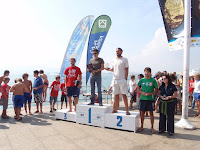In the end, I swum Gibraltar for a few reasons, none of which seemed all that clear to me at the time (although I am sure that there were what pushed me to do the swim), but mostly I was stuck debating the use of a wetsuit. The reasons for swimming the Strait, however, have all come to light during this post Gibraltar week in Madrid, and I couldn‘t be happier about my decision to swim the Strait. The first reason was that I had been planning to do it since I arrived in Spain, and had been training intensely since I got here, something which has taken a lot of focus and determination. The second, and for me the most important reason, is that I wanted to complete the swim in recognition of the kindness and support that has come my way from the newfound friends in Spain, the people who fed me and helped me to train and encouraged me along the way- I actually felt obliged to do the swim. I also simply wanted to have the luxury of swimming for a really long time in the open ocean, to swim for so long that I could forget about time and even space and just feel the cool expanse of the waters around (and also feel protected by the support boat that accompanied me). And the final reason for swimming across Gibraltar is that I hope to organize a team of Moroccan, Spanish, and American (U.S.) swimmers, and complete a round trip traverse of the Strait as a relay in July of 2010. Completing the swim on my own has given me the confidence and the expertise to organize this swim.
The Strait of Gibraltar is not only the tiny piece of water that separates the European and African continents (as well as the wealth of each country), but it is also the confluence of the waters of the Mediterranean Sea with the Atlantic Ocean. The tides and currents in the Strait are, in blunt, gnarly. Standing on any hill in Tarifa that overlooks Gibraltar, one can clearly see the waters moving via strong currents. Distinct zones within the Strait are visible, defined by what looks like a river of white caps flowing past a body of calm water. Interestingly enough, I was told that the passages of calm waters are actually, where the lateral currents are strongest: the white caps are formed by the wicked winds that persist in the Strait, and the currents can be so strong that they actually tear the white caps apart and calm the waters.
To swim across Gibraltar requires a keen knowledge of the tides and currents of the region. The shortest distance between the point at Tarifa and the African continent is 15km- to Point Cires on the Moroccan coastline (although I’ve heard that it is only 14km or that it is actually 16km). Ideally, you would land at this point, but the currents and the tides are such that this doesn’t happen all that often. The worst place to land would be in Ceuta, which is about 8km to the east of Point Cires and is actually part of Spain; a small Spanish enclave on the African continent. Either if the current pushes you far enough east, because you aren’t swimming fast enough to battle the currents, or because the currents are particularly strong that day, you can potentially end up in Ceuta. Arriving in Cueta is really the last chance to hit land, because if you miss Ceuta, the coastline turns sharply south and you'll never reach the coast, and so the support boat has to take you out of the water. The basic strategy, or the strategy that is most often employed, and that which we used for my swim, was to time the swim for the end of the high tide to take place during the middle of my traverse. This allows for a period of no tidal movement as the high tide recedes into low tide. When the tide is building, lateral currents generally move strongly to the east. When the tide is at bay, there is a period of relatively weak lateral currents. And when the tide is going down, the lateral currents are said to move to the west. Thus, if the changing of the tides takes place at the middle of the traverse, during the first part of the swim the currents would push you to the east, during the mid part you could make good forward progress with relatively weak lateral currents, and during the last part (with the tide going out), the currents would push you back west. Thus, the ultimate trajectory of the swim would be a straight line south from Tarifa to Point Cires, although you would have swim in a sideways V. These are all general patterns, and in large part due to the heavy winds of the region, the Strait of Gibraltar is known to have very erratic currents that defy these patterns.
(http://encarta.msn.com/map_701516790/gibraltar_strait_of.html)



























